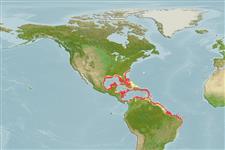Common names from other countries
Classification / Names / Names
Nomi Comuni | Sinonimi | Catalog of Fishes (gen., sp.) | ITIS | CoL | WoRMS
Environment: milieu / climate zone / depth range / distribution range
Ecologia
Associati a barriera corallina; distribuzione batimetrica 1 - 384 m (Ref. 83934). Tropical; 34°N - 17°S, 97°E - 0°E (Ref. 83435)
Western Atlantic and the Mediterranean.
In the past identified as Charonia tritonis in the Mediterranean.
Length at first maturity / Size / Peso / Age
Maturity: Lm ? range ? - ? cm Max length : 37.4 cm DL maschio/sesso non determinato; (Ref. 83435); common length : 33.0 cm TL maschio/sesso non determinato; (Ref. 355)
Shell elongate, large, heavy. Spire pointed, elongate. Anterior canal very short. Varices present on last whorls. Parietal region with narrow dark brown inner lip covered by regularly spaced, spirally oriented, white, cord-like plicae. Outer lip internally with pairs of fine white teeth superimposed on square blotches of dark brown colour. Colour: cream white with brown markings, usually crescent-shaped.
This species is found shallow subtidal (Ref. 355), and on offshore coral reefs and cienaga facies, particularly on algae, boulder, coral, rock, sand and shell habitats (Ref. 83934).
Life cycle and mating behavior
Maturità | Riproduzione | Deposizione | Uova | Fecundity | Larve
Members of the order Neotaenioglossa are mostly gonochoric and broadcast spawners. Life cycle: Embryos develop into planktonic trocophore larvae and later into juvenile veligers before becoming fully grown adults.
Leal, J.H. 2003. (Ref. 355)
IUCN Red List Status (Ref. 130435)
CITES status (Ref. 108899)
Not Evaluated
Not Evaluated
Human uses
Pesca: commerciale
| FishSource |
Strumenti
Fonti Internet
Estimates based on models
Preferred temperature
(Ref.
115969): 17.9 - 27.1, mean 23.8 (based on 157 cells).
Price category
Unknown.
